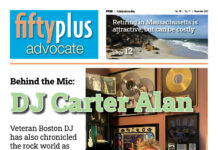By Ted Anthony
BETHEL, N.Y. —
His overalls are weathered. His white beard is grown out to aging-hippie perfection. The tattoos on his arms tell the story of a moment from the summer of 1969 that has passed into legend — three days of peace and music that became a doorway to defining an era.
Around him sits the patch of upstate New York farmland that gave birth to a piece of modern mythology — Woodstock. At 68, Duke Devlin reflects on the definitive concert of his youth by spinning tales of community and anti-authoritarianism that end, invariably, with the word “man.” As in, “Sometimes I’m amazed that we’re still talking about this, man.”
Of course we’re still talking about it. And, as a historical interpreter at the festival’s site, it’s Devlin’s job to talk about it, to tell the story of the ’60s. Unlike so many today who say they were at Woodstock, he actually was. And still is.
Woodstock was a flashpoint, a culmination, one easy way to distill a complicated decade into something digestible. That it happened as the 1960s ended made it all the more convenient: Here was an empty vessel, complete with soundtrack and instantly mythic imagery that provided the perfect raw material to build a narrative around an era.
A half century after the 1960s began, that is precisely what we have done with the decade — and with the 10-year periods that came before and after it. We’ve wrestled them into grand stories with convenient contours and reliable patchworks of imagery. And when it comes to the ’60s, what a confusing, disjointed patchwork it is.
For every textured civil-rights documentary, there is a $15.95 inflatable beehive hairdo. For every meticulously researched history of the protest movement, there is a Walmart peace-sign spiral notebook. For every Duke Devlin, there is an Austin Powers.
The 1960s have been idealized and vilified, romanticized and boiled down into a cultural demiglace with an intense taste but very little of the subtlety that the real decade offered.
“It’s no longer self-expression. It’s a fashion,” said Wade Lawrence, director of the Museum at Bethel Woods, which oversees the site where Woodstock happened. “We like simple things. We like sound bites. We like a simple, one-sentence explanation of an era.”
And so it is with the country’s view of its recent history. In America, the past is raw material. History gets compressed, packaged, marketed. Into the grinder goes complexity; out comes cliché. And we help it along, deciding arbitrarily that a decade — the time between two years that end in zeros and little more — is a useful way to measure history.
Devlin trolls the Woodstock site on a golf cart, his enthusiasm undiminished by time’s passage. “Something happened here,” he said. But as with the rest of that decade in America, what it was still ain’t exactly clear.
The notion of a decade as a distinct unit of time has existed through much of American history, but it wasn’t until the 1920s that life sped up enough for one 10-year period to be considered an era with its own unique identity.
It didn’t hurt that the first decades after World War I aligned themselves with historical currents. You can view the ’20s pretty reasonably from 1918 to 1929 (the end of World War I through the market crash), and the ’30s as 1929 to 1941 (the Depression to World War II).
Then it gets more complicated. What were the ’40s — as narrow as the war years of 1941-1945 or as broad as 1939-1951? What were the ’50s? Some make the case that they began in 1946.
And the ’60s? Even thornier.
One person will assert they began with Kennedy’s inauguration (1961) and ended with the shootings at Kent State (1970). Another might count from Kennedy’s assassination (1963) until Nixon’s resignation (1974) or even until Saigon fell (1975).
Once you divide the century into distinct periods, each becomes far easier to package and sell. The 1920s were flappers and spats and gangsters and speakeasies. The 1930s were bread lines and dust-bowl shacks and fireside chats and the silver screen. The 1940s were GIs and big bands and Rosie the Riveter and Levittown. The 1950s were sock hops and Ward Cleaver and Elvis and Tupperware.
Skip to the 1970s — pet rocks and mood rings and Farrah and disco and maybe, if you’re serious-minded, Watergate and the energy crisis. Whereas the ’80s were thin ties and mousse and legwarmers, wine coolers and Rubik’s Cubes and Miami Vice pastels. Not to mention the fall of communism.
But let’s zoom in on the many long, strange trips that began in 1960 and led, today, to what we know as “the 1960s.”
One journey begins with the Kennedy era — the uneasy segue from Eisenhower-era conformity and simmering discontent into the coming decade’s tumult — and comes out the other end as mod furniture, lounge music and the Mad Men cocktail-mixing iPhone app.
Another begins with the Cuban missile crisis, anti-Communist paranoia and militant radicalism, and emerges as Chairman Mao coffee mugs and Che Guevara T-shirts on sale at the mall.
Another begins with subversive drug experimentation and complex anti-authoritarianism, and emerges as theme restaurants and bars that feature lava lamps, beads hanging over doorways and posters with swirling, ballooning typefaces.
Still another begins with Woodstock and comes out the other end as novelty-shop products from Forum Novelties of Melville, N.Y. — items like the “Generation Hippie Costume Kit,” containing a mustache, wig, sideburns and glasses (with “patchwork shirt” as an “optional accessory”).
Then there are the thematic ’60s: The mod ’60s. The folk ’60s, which grew into the psychedelic ’60s, which are related to the sitar-and-yoga ’60s. The civil-rights ’60s, which intersect with the Camelot ’60s and the war-on-poverty ’60s. The Living Room War ’60s, which collide with the what-are-these-damn-kids-doing ’60s. The hippie, yippie, Haight-Ashbury ’60s, the bra-burning ’60s, the Helter-Skelter ’60s.
Each contains kernels of truth and a heavy dose of myth. All overlap. Many are in conflict. It’s complicated, but you wouldn’t know that by how we consume the decade today — neatly, coherently, everything the real ’60s weren’t.
Just listen to the satellite radio stations that package every decade from the 1940s through the 1990s by their songs. Push a single button and you can ride through the 20th century on a musical time machine, zooming straight from Glenn Miller to the Backstreet Boys in 15 seconds.
The only problem: It’s utterly arbitrary. Teen Angel, so evocative of a 1950s high-school dance, might show up on the ‘60s station because it topped the charts in February 1960. But cuts from the Beatles’ swansong album Let It Be, released in 1970, belong to the ’70s channel. It’s hard to keep track.
“The present now will later be past,” Bob Dylan sang. “The order is rapidly fadin’.”
In a remix culture, decade-driven history can bewilder. How many Americans learned about the ’70s through That ’70’s Show (1998-2006) or the ’50s through Happy Days (1974-84)?
But so what? Why not summon history through the rearview window of popular culture? After all, this stuff became iconic for a reason: At some point, it really meant something. It was a soundtrack to coming of age. And many people — now simply aging — don’t want that to go away.
Packaging history is a natural instinct, particularly today when so much that comes at us is fragmentary and disjointed. Humans have to wrangle time, to organize it into containers that make sense of life.
But packaging some things means leaving important others behind. We can, in effect, choose our 1960s from a buffet of cultural fragments. And each depends upon what the package is trying to sell.
If you’re Nostalgiaville USA, the 20th-century trinket emporium along I-70 in Kingdom City, Mo., PEZ dispensers and Laugh-In photos and other pop iconography are your bread and butter. You’re not really focusing on the poor Appalachians that LBJ and RFK tried to help.
If you’re the chain store Party City, you traffic in costumes that will immediately evoke the “fun” 1960s, not James Meredith desegregating Ole Miss. If you’re producing The Wonder Years, you gin up grainy home movies for your opening credits and overlay a snippet of Joe Cocker singing at Woodstock.
But as time goes by, these anecdotal stand-ins shift to the front row. Instead of just evoking a decade, they become how we think about it. Then we start misremembering the past. Worse, we don’t even know we’re doing it.
When we consume packaged versions of our past, we’re often seeking entertainment. But history is not always fun. It’s dirty, confusing, complicated and sometimes downright unpleasant.
The Depression was certainly unpleasant — and became fodder for a line of clothing based on Dorothea Lange’s photos of dust-bowl misery. The 1950s were a blend of prosperity, paranoia and discontent — and are now evoked across the country by milkshake-toting carhops in saddle shoes and ponytails roller-skating to Mr. Sandman.
The period between John F. Kennedy’s assassination and Saigon’s fall was one of the most tumultuous of all, yet Billy Joel manages, in the poppy history anthem We Didn’t Start the Fire, to sum it up like this: “Birth control, Ho Chi Minh, Richard Nixon back again. Moon shot, Woodstock, Watergate, punk rock.”
There are exceptions. Mad Men meticulously slices the 1960s into detailed segments, painstakingly avoiding cliché as it examines the lives Americans lived as change swirled around them. HBO’s new “Boardwalk Empire” is doing the same thing with the 1920s.
The ’60s as a historical period are in danger of becoming more misunderstood than ever — precisely because of their endless redistillation by people with stories to tell and products to sell.
Today, tourists come to Woodstock in sandals and tie-dye T-shirts, not knowing — or perhaps not caring — that few at the concert actually wore tie-dye. For most Americans, Woodstock has become a data point for cultural marketing, remixed and repurposed as much as the peace sign itself. In an era when half of Americans were born after Kent State, the 1960s are raw material for evoking emotions, moments, desires.
Learning from history — teaching our children well, particularly when it comes to a decade that changed us so much — requires more than clichés and contextless fragments.
“You try to help students see, trends don’t automatically shift once that zero comes,” said Jeanne Petit, a historian at Hope College in Holland, Mich., who teaches today’s college students about their parents’ and grandparents’ world. “When people see the ’60s in those simplified terms, it’s easy to simplify the political debates today.”
We see the world, the saying goes, through a glass, darkly. And when the complexity of a decade is illuminated with cheap flashlights, things can cloud up even more. The past fades. The same perils present themselves. And if we’re not careful, history repeats itself.
What we wish to have happened is one thing; what really happened is starkly different. Could it be that, instead of processing and understanding complex historical periods, we have simply domesticated them so they no longer can bite?
Imagine a 2000s theme party in, say, 2035. Your guests will snack on Mario Batali frozen hors d’oeuvres, dance to Single Ladies and wear Snooki outfits. The guy in the corner might be dressed as Tony Soprano or Simon Cowell. You probably won’t see much 9/11 imagery. The inevitable nostalgic conversations won’t extend to discussions about the Afghanistan or Iraq wars. Most of the decade’s other defining themes — the fading of the American middle class, the collapse of the financial industry, the erosion of privacy and the runaway political polarization — have no place here, either.
It’s a party, after all. There is fun to be had, imagery to be consumed, a past to be packaged. And in the only country where “the pursuit of happiness” is enshrined in the founding document, the tension between history and “history” is a sure thing every time. — AP












